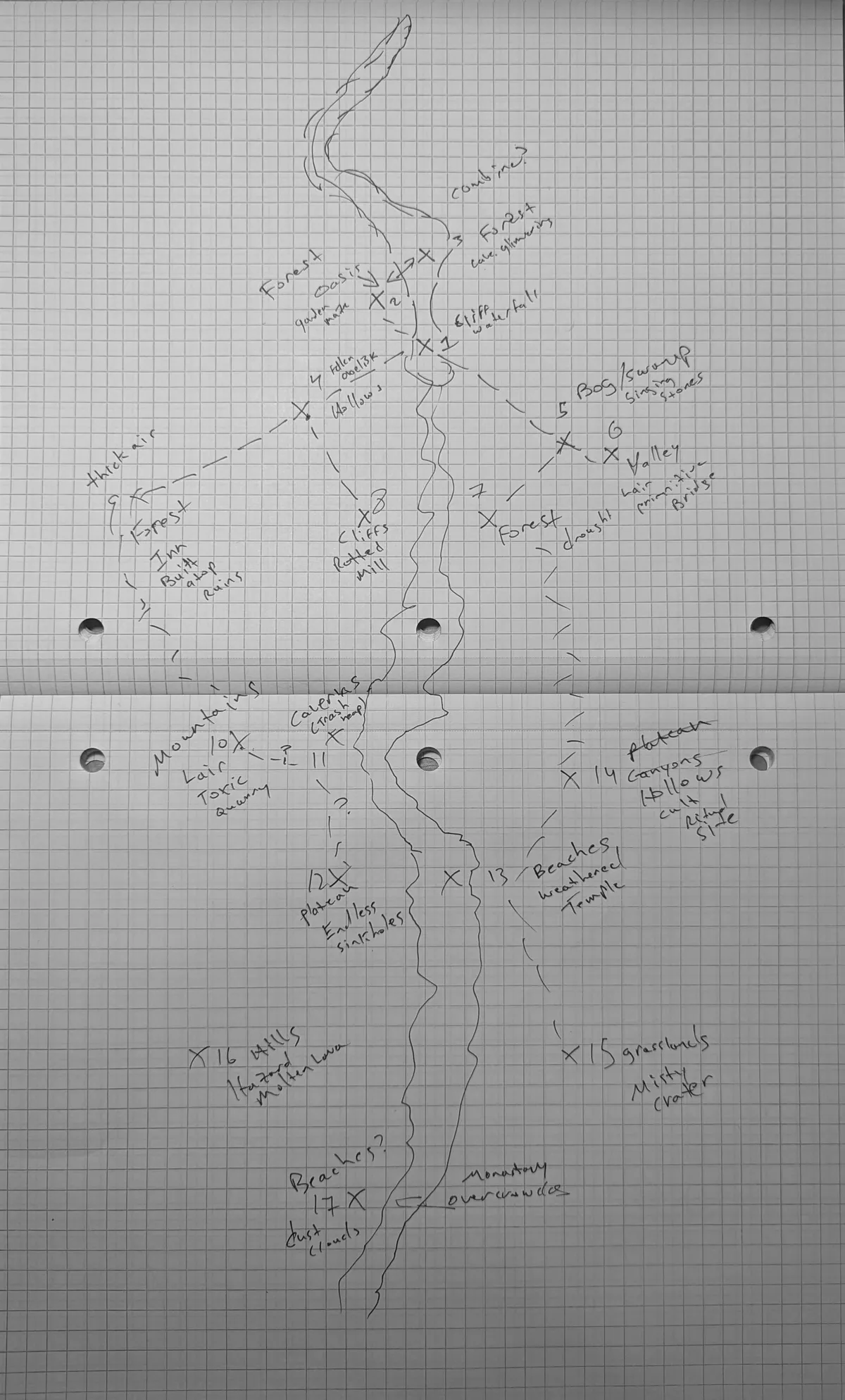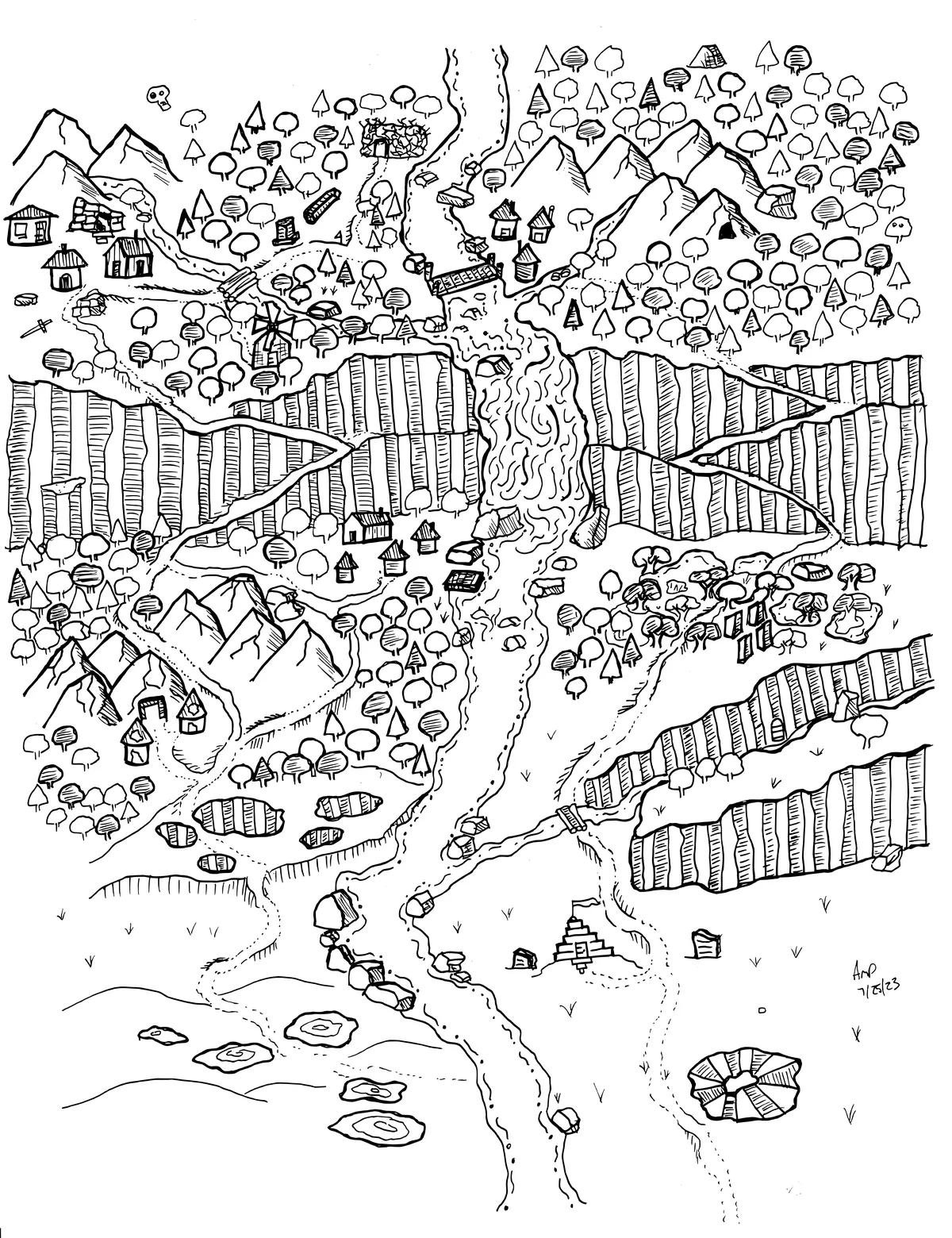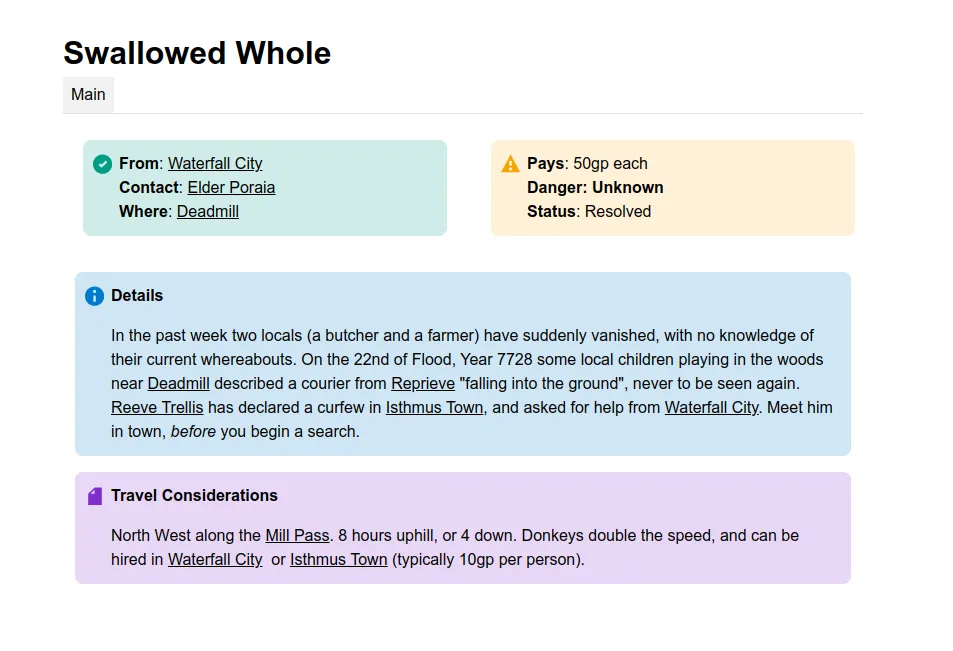Pointcrawls & Emergent Play
Two years ago, I ran a West Marches campaign using the tools from the Cairn Second Edition Warden's Guide. It was a lovely campaign. Games were almost never canceled, as new players would fill any open slot, and we were able to build a steady party of at least three players who would always show up.
Each session, the PCs would uncover more and more of the campaign world, solving mysteries and creating new reasons to continue exploring the wilds. We stopped only because I needed to focus on finishing the Box Set. Even today, I feel like we could get it going again in a snap!
The map was a pointcrawl, and I am very glad I chose to do it this way over a more traditional hex crawl.
Why Not Hex Crawls?
For some time, I've heard the following (probably strawman) argument that hex crawls are the best way to play a sandbox-style, wilderness exploration game. Folks will say that the "six degrees of choice" and simplified abstraction of boundaries offer a unique way to play. They say that only in a hex crawl can a party blindly wander into a neighboring hex, capturing that familiar sense of whimsy from the old days that our hobby is keen to remember.
I am not here to dispute any of that; in fact, I think hexcrawls are great! What I do believe, however, is that pointcrawls offer the same sort of flexibility and feeling of exploring the unknown and can even provide players with the same level of agency and freedom hex crawls arguably promote. In my games, players are not simply moving from node to node, ignoring what lies in between. They are just as prone to weather, supplies, and random encounters as in a hex crawl, and they are equally free to pick any direction and simply go, regardless of how prepared I am or how much information they have.
I've also heard folks say that a problem with pointcrawls is that they are not as naturally suited for games where the PCs must cross into unexplored territory (e.g., going places where the roads don't lead). This is simply not the case in my experience! In Cairn, paths between points are often not on roads or trails, crossing over land and waterways alike. These terrain types significantly affect the duration and risks of travel!
The Rules
In my West Marches game, all players operated under the following expectations:
- We would play using the Cairn Second Edition rules (especially the procedures for Wilderness Exploration).
- We would play online using Discord, Shmeppy, and LegendKeeper (and later, Kettlewright).
- All players would follow the code of conduct (borrowed from a West Marches campaign by Jason Lutes).
- Players would sign up on a public calendar, and games could have no more than 6 players.
- Sessions were on Sunday at 9 a.m. Eastern Time and would typically run for 3.5 hours.
- Anyone from the roster of 20 or so players could join, provided there was an open slot.
- Players would roll up their characters in advance of play. The "youngest" character would also roll for an Omen.
- An in-game Calendar helped keep track of world events. I used a similar Discord channel structure to my Play By Post.
- The party would maintain a storehouse where items gathered during expeditions could be kept (for a fee) and taken out as needed.
- I would provide the players with 2–3 "Jobs" to choose from at any given time. Jobs would need to be selected by a specific date.
- Planning, strategizing, and general chat happened on Discord, but nothing "in-game" could happen there (except for Downtime Actions).
- All sessions would begin from the same location (a bastion at the edge of an "untamed" wilderness).
- As with most West Marches games, the "trip back" to civilization was hand-waved, excluding any general upkeep.
These rules worked great for us.
The Map
I built the region using the Cairn Second Edition procedures. I generated basic information about the region, its people and factions, terrain, and so on. For the map, I followed the process and drew rough terrain over a medium-sized region, then sprinkled each die result for each POI (Point of Interest) throughout. I made sure to leave plenty of space for the "border" into the unexplored wilderness, of course. I didn't flesh anything out just yet, either.
Here was my initial map:

I then created a pointcrawl using Miro, noting the distances between each location as per the Wilderness Exploration rules. Take a look at the Warden's view:
At first, I started with only a dozen or so points, but continued to add them as we went along.1
The player-facing map was actually drawn by my friend Amanda P.:

I superimposed the known nodes over the map in LegendKeeper so that the players could easily navigate around. At first, this comprised only a small area (essentially the starting city and some nearby locales).
Points of Interest
In the initial map, you can see phrases like "Beaches / Weathered Temple" or "Forest / Inn Built Atop Ruins" written in my poor handwriting. These were largely left untouched, as I wanted the players to discover their secrets during play. I did flesh out the starting city (or Heart) a bit, as well as some nearby towns and forests.
Getting Started
Players were provided with basic information about the world, its factions, and so on. They were then asked to make a selection from the job board (I started with two). Depending on which they chose, their starting location would change, as well as where they would need to travel to speak to whoever was providing them with their quest. I chose the points nearest the border and came up with brief quest hooks: a missing porter, an underground temple, and so on.
Here is an example job:

I actually based it on an Omen:
"The night sky grows dimmer each evening, as if stars are disappearing one by one. Rumors of hellish creatures capturing farmers and pulling them into the Roots are spreading like wildfire. Village elders believe the two are connected."
And here is another:

The players selected a job and strategized about their best path forward. I would usually give them until the Wednesday before the next session to choose a job, leaving me only three days to write the adventure. Fortunately, I was able to follow the Dungeon Seeds and Forest Seeds procedures to build out their potential destinations. For points in between, I would generate a few interesting situations along each route. If the party never met these encounters, there was always next time!
I then riffed a bit on what I had already generated:
Sinkholes + Trash Heap
- Waste workers throw huge heaps of garbage into the sinkhole.
- A makeshift pulley system descends into the sinkhole. No one is around at present.
I'd recently heard of a sinkhole swallowing a house in South America and thought it sounded like a cool location for an eventual adventure. Sadly, this never happened. But it sure made the place feel alive as the PCs passed by!
Grasslands + Misty
- Knee-high mist.
- Thousands of broken jars.
- In the nearby river, Reedfolk carry a large River Ray tied to four pikes.
I didn't know what any of this meant at the time. I had a vague idea as to who the Reedfolk were, and I'd recently visited Costa Rica, so I wanted to do something with stingrays. The broken jars eventually worked themselves into a nearby dungeon theme.
Playing to Find Out
After the first session, I repeated the process, generating new POIs as the players explored the map. Sometimes they would choose to explore a far-off region, and I had to scramble, adding new terrain, landmarks, and waterways. Typically, I would be able to predict what the players would choose to do, but not always! I once had to "wing it" when the players selected a job I had not expected, and due to life reasons I ran out of time developing it! Falling back on an Omen once more, I came up with a straightforward escort mission about a faction leader heading south to watch a volcano erupt.
I then generated a dozen or so characters with my NPC generator from the Warden's Guide (names changed to protect the innocent):
| Name | Background, Goal, Quirk, Virtue, Vice |
|---|---|
| Azad | Spy, Preservation, Alert, Discreet, Aloof |
| Pyle | Thief, Domination, Bright Eyes, Tenacious, Impulsive |
| Gramme | Merchant, Wealth, Limps, Shrewd, Deceptive |
| Bala | Lord, Freedom, Young, Honest, Selfish |
| Comte | Academic, Unity, Gaunt, Polite, Naive |
| Lorne | Peddler, Enrichment, Strong, Disciplined, Vain |
| Taylor | Peddler, Wealth, Muscular, Honest, Craven |
| Konrad | Lord, Power, Crooked Teeth, Pragmatic, Cruel |
| Callan | Guard, Disciplined, Good Posture, Peace, Inflexible |
Quickly, a scenario began to unfold:
- A noble and a scholar (Bala and Comte) fell in love, then fled to avoid the repercussions. They hired a money-driven merchant (Gramme) to take them in his wagon, following the pilgrims south.
- An aloof pilgrim (Azad) travels with the caravan. In actuality, she is Bala's sister, disguised as a man to avoid detection. Her goal is to find her sister and bring her home.
- A wealthy noble (Konrad) has decided to join the entourage and can identify Bala.
- A pair of siblings (Lorne and Taylor) travel alongside a silent knight (Callan) who is, in fact, an enchanted suit of armor, intent on ending its miserable existence in lava.
- Meanwhile, a wandering mystic (Pyle) seeks an audience with the volcano for reasons unknown.
This gave me plenty to go on, and with the players driving play, we had a wonderful session filled with intrigue and social dynamics. At one point, two of the five PCs split off to follow a suspicious pair of would-be assassins, relying on the Wilderness Exploration rules (specifically the Explore Action) while the remainder of the party slept or guarded their charge.
They had no idea where the people they were tailing would go or what they would find. Lots of craziness ensued. When they'd finished their bloody work, they needed to somehow catch up with the rest of their party but didn't know exactly where the others were.
Meanwhile, the escort party continued on its mission, encountering all sorts of friends and foes along the way. The two parties were split, with half traveling along a "known" route and the other half taking an entirely different path toward the same general destination!
The second party knew the escort planned on taking a boat along the Scar, a south-flowing river. They used logic and local knowledge to figure out where the river was and actually managed to beat the escort to its destination despite never having been there.
Retreading Old Ground
In one of our early sessions, the PCs successfully solved a murder but were unable to capture all those responsible. An NPC called Fasha (also see Trouble in Twin Lakes) fled the scene but reappeared in two future sessions! The first time, he returned as the kidnapper of a trapper and his daughter, whom the PCs were sent to rescue. The party had no idea he was behind their disappearance (and neither did I, at first). But as the party explored the Stone Forest, it became clear to me that things were connected in a way I hadn't initially anticipated. Unfortunately, Fasha was already gone (determined by dice rolls) by the time the PCs arrived at his hideout. However, there was enough evidence left behind for the party to know whom they were up against!
Prior to entering the deep woods, the party came across a landmark (White Tower Grove), where they decided to rest and wait out the rain (weather events are SO important!). This led to a half-session mini-dungeon crawl that revealed information about the land's former denizens as well as a useful bucket of portable acid.
It wasn't until many sessions later that an inspired player decided to use their Downtime Action to research the whereabouts of the villainous Fasha, only to discover that his most likely location was the very same tower the party had found in the second session of play!
Of course, the following session resulted in a return to this tower and a final showdown with Fasha. Good times. It was only the midpoint of the campaign at that time, but the Growth some of the PCs experienced made the game very special to all of us.
What I appreciated about this event is that the original landmark was just that: a point on the map, visible from elsewhere. But after the PCs expressed interest in returning, I was able to flesh out the nearby grove into a full forestcrawl full of traps and intrigue. This experience was entirely unplanned and player-driven.
Natural Barriers
At one point, the party arrived at the edge of a great wood, its boundary defined by a steep ravine. Following the abandoned lumber trails into the wood, the PCs discovered that a fallen tree was the forest's only ingress. Initially, I'd simply rolled for a Curiosity in the Setting Seeds chapter, getting "Hanging Bridge + Unstable Ground," and thus the following scene was born:
Root Bridge
Two trees sprout from either side of a small ravine. Between them, a massive, twisted root forms a natural bridge, covered in moss.
- Bridge: Around 40 ft. long. Sturdy and broad, but dangerous when wet due to the slick moss that grows all around it.
The PCs (and their hireling) could either risk trying to cross (DEX save) or spend more time looking for a different way across. Fortunately for them, one of their party members had the Control Plants Spellbook, which they used to manipulate the moss and ensure a safe crossing.2
In another instance, the party passed through a series of caves, coming out on the other side of a mountain onto a sheer cliff, high above the jungles below. In the distance, they could see a large mound, and from the nearby smoke they judged it to be a human settlement of some kind (it was a dungeon, haha). Somehow, the party had to figure out how to get down. Unfortunately, their resources did not include a rope of sufficient length. They concluded they would build a human chain of bodies (and rope), allowing one party member to climb down safely and build a drop-site!
These are just a few of the many examples of players using wits and critical thinking to overcome the challenges of physical geography.
A Note About Getting Lost
In Cairn, any party traveling off-road without a map or guide has a decent chance of getting lost. Their risk increases (or decreases) depending on path type, terrain difficulty, and weather. Since we were playing a West Marches game, the PCs were hiking over raw terrain or overgrown trails much of the time. They were clever enough to bring along hirelings to help avoid this fate (and others), or to help them find whatever quarry they were after. When they did get lost, they would spend an extra Watch (essentially half the day) finding their way back. However, they still had to suffer whatever consequences the Wilderness Events table threw their way. I typically do not make this experience pleasant for a lost party.
Conclusion
I'm a bit sad we had to stop playing due to writing constraints, in part because many of our adventures became published modules. I've got about six more from that time that are primed for release…someday.
I hope this has made folks at least curious about pointcrawls and why I find this mode of play so much fun.